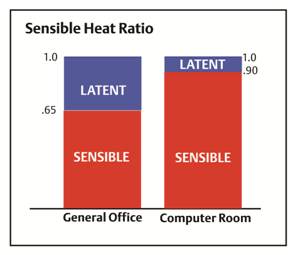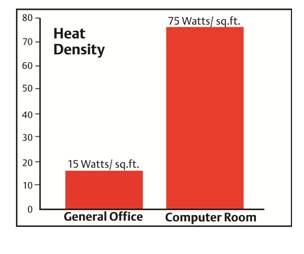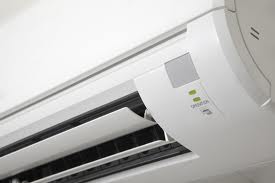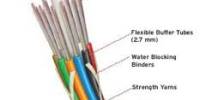Air conditioner
Air conditioning is the removal of heat from indoor air for thermal comfort. In another sense, the term can refer to any form of cooling, heating, ventilation, or disinfection that modifies the condition of air. An air conditioner (often referred to as AC or air con) is an appliance, system, or machine designed to stabilize the air temperature and humidity within an area (used for cooling as well as heating depending on the air properties at a given time), typically using a refrigeration cycle but sometimes using evaporation, commonly for comfort cooling in buildings and motor vehicles.
The concept of air conditioning is known to have been applied in Ancient Rome, where aqueduct water was circulated through the walls of certain houses to cool them. Similar techniques in medieval Persia involved the use of cisterns and wind towers to cool buildings during the hot season. Modern air conditioning emerged from advances in chemistry during the 19th century, and the first large-scale electrical air conditioning was invented and used in 1902 by Willis Havilland Carrier. Now-a-days we cannot think a day without air conditioner.
History
The 2nd century Chinese inventor Ding Huane invented a rotary fan for air conditioning, with seven wheels 3 m (9.8 ft) in diameter and manually powered In 747, Emperor Xuanzong had the Cool Hall (Liang Tian) built in the imperial palace, which the Tang Yulin describes as having water-powered fan wheels for air conditioning as well as rising jet streams of water from fountains. During the subsequent Song Dynasty (960–1279), written sources mentioned the air conditioning rotary fan as even more widely used.
In the 17th century Cornelius Drebbel demonstrated “turning Summer into Winter” for James I of England by adding salt to water.
In 1758, Benjamin Franklin and John Hadley, a chemistry professor at Cambridge University, conducted an experiment to explore the principle of evaporation as a means to rapidly cool an object. Franklin and Hadley confirmed that evaporation of highly volatile liquids such as alcohol and the air could be used to drive down the temperature of an object past the freezing point of water. They conducted their experiment with the bulb of a mercury thermometer as their object and with a bellows used to “quicken” the evaporation; they lowered the temperature of the thermometer bulb down to 7°F while the ambient temperature was 65°F. Franklin noted that soon after they passed the freezing point of water (32°F) a thin film of ice formed on the surface of the thermometer’s bulb and that the ice mass was about a quarter inch thick when they stopped the experiment upon reaching 7°F. Franklin concluded, “From this experiment, one may see the possibility of freezing a man to death on a warm summer’s day”.
In 1820, British scientist and inventor Michael Faraday discovered that compressing and liquefying ammonia could chill air when the liquefied ammonia was allowed to evaporate. In 1842, Florida physician John Gorrie used compressor technology to create ice, which he used to cool air for his patients in his hospital in Apalachicola, Florida. He hoped eventually to use his ice-making machine to regulate the temperature of buildings. He even envisioned centralized air conditioning that could cool entire cities. Though his prototype leaked and performed irregularly, Gorrie was granted a patent in 1851 for his ice-making machine. His hopes for its success vanished soon afterwards when his chief financial backer died; Gorrie did not get the money he needed to develop the machine. According to his biographer, Vivian M. Sherlock, he blamed the “Ice King”, Frederic Tudor, for his failure, suspecting that Tudor had launched a smear campaign against his invention. Dr. Gorrie died impoverished in 1855 and the idea of air conditioning faded away for 50 years.
In 1902, the first modern electrical air conditioning unit was invented by Willis Haviland Carrier in Buffalo, New York. After graduating from Cornell University, Carrier, a native of Angola, New York, found a job at the Buffalo Forge Company. While there, Carrier began experimentation with air conditioning as a way to solve an application problem for the Sackett-Wilhelms Lithographing and Publishing Company in Brooklyn, New York, and the first “air conditioner”, designed and built in Buffalo by Carrier, began working on 17 July 1902.
Designed to improve manufacturing process control in a printing plant, Carrier’s invention controlled not only temperature but also humidity. Carrier used his knowledge of the heating of objects with steam and reversed the process. Instead of sending air through hot coils, he sent it through cold coils (ones filled with cold water). The air blowing over the cold coils cooled the air, and one could thereby control the amount of moisture the colder air could hold. In turn, the humidity in the room could be controlled. The low heat and humidity were to help maintain consistent paper dimensions and ink alignment. Later, Carrier’s technology was applied to increase productivity in the workplace, and The Carrier Air Conditioning Company of America was formed to meet rising demand. Over time, air conditioning came to be used to improve comfort in homes and automobiles as well. Residential sales expanded dramatically in the 1950s.
In 1906, Stuart W. Cramer of Charlotte, North Carolina was exploring ways to add moisture to the air in his textile mill. Cramer coined the term “air conditioning”, using it in a patent claim he filed that year as an analogue to “water conditioning”, then a well-known process for making textiles easier to process. He combined moisture with ventilation to “condition” and changes the air in the factories, controlling the humidity so necessary in textile plants. Willis Carrier adopted the term and incorporated it into the name of his company. This evaporation of water in air, to provide a cooling effect, is now known as evaporative cooling.
The first air conditioners and refrigerators employed toxic or flammable gases, such as ammonia, methyl chloride, and propane that could result in fatal accidents when they leaked. Thomas Midgley, Jr. created the first chlorofluorocarbon gas, Freon, in 1928.
Freon is a trademark name owned by DuPont for any Chlorofluorocarbon (CFC), Hydrogenated CFC (HCFC), or Hydro fluorocarbon (HFC) refrigerant, the name of each including a number indicating molecular composition (R-11, R-12, R-22, R-134A). The blend most used in direct-expansion home and building comfort cooling is an HCFC known as R-22. It is to be phased out for use in new equipment by 2010 and completely discontinued by 2020.
R-12 was the most common blend used in automobiles in the US until 1994 when most changed to R-134A. R-11 and R-12 are no longer manufactured in the US for this type of application, the only source for air conditioning purchase being the cleaned and purified gas recovered from other air conditioner systems. Several non-ozone depleting refrigerants have been developed as alternatives, including R-410A, invented by Honeywell (formerly AlliedSignal) in Buffalo, and sold under the Genetron (R) AZ-20 name. It was first commercially used by Carrier under the brand name Puron.
Innovation in air conditioning technologies continues, with much recent emphasis placed on energy efficiency, and on improving indoor air quality. Reducing climate change impact is an important area of innovation, because in addition to greenhouse gas emissions associated with energy use, CFCs, HCFCs and HFCs are, themselves, potent greenhouse gases when leaked to the atmosphere. For example, R-22 (also known as HCFC-22) has a global warming potential about 1,800 times higher than CO2.[9] As an alternative to conventional refrigerants, natural alternatives like CO2 (R-744) have been proposed.
Precision type Air Conditioner (PAC)
Compared to yesterday’s monolithic telephone system, today’s worldwide communications network is a much more complex and constantly evolving cluster of interconnected systems. And with continually more mission-critical processes reliant on transmission accuracy and 100 percent uptime, the requirements for reliability and performance have never been greater. Precision air conditioning is one keystone of a well-designed support system for this network.
Difference between Precision type Air Conditioner and Comfort Air Conditioner
Efficient, reliable, operation of business critical computer system is essential to the success of companies in virtually every industry. The cost of downtime is high, which even a short interruption causing the potential loss of productivity, profits and customer goodwill. And business critical computers are no longer clustered only in one centralized location. Many organizations today have multiple data centers, including smaller centers at remote locations.
Often small or remote data centers don’t benefit from the same attention to support system design as large data centers, despite the fact that the coasts associated with down time from the systems they house can be remarkably high. One area, in particular, that may be receiving inadequate attention is environmental control: Whether through rapid growth results in the data centers “outgoing” its support system- or lack of understanding of the cooling requirements of sensitive electronics, some users end up trying to use comfort cooling for precision electronics.
The result is increased risk for premature failure of protected equipment and higher than necessary operating cost.
Precision cooling systems are designed specifically to meet the needs of dense electronic loads, which generate a dryer heat than typical comfort- cooling environments and require year-round, 24 hour cooling. Electronics are also more sensitive to variations in humidity and air quality than typical comfort- cooling environments.
When a decision is made to accept the increased risk of using comfort cooling systems for sensitive electronics, it is usually based on higher initial cost of the precision cooling system. But, because precision cooling systems are designed and sized for the high sensible cooling requirements and year-round operation of the data center, they are less expensive to operate over their life than comfort systems. Consequently, when initial costs are operating costs are both taken into account, precision cooling systems actually represent the most cost-effective solution to cooling sensitive electronics.
Precision Vs comfort Cooling
Consideration given to the planning and design of equipment essential to reliable data center operation is often less than given to other aspects of the facility planning process, particularly in smaller or remote facilities. Areas such as environmental control, power reliability and effective monitoring of critical computer support systems receive far less attention than decisions about servers, operating systems and network configurations. Yet, the performance of these systems is as dependent on power and environmental support systems as on the network connection.
The combination of heat generation and sensitivity of electronic components in data center computer and network systems requires that temperature, humidity, air movement and air cleanliness be maintained within stringent limits.
Precision cooling systems have been designed specifically for this purpose. Available comfort cooling systems are occasionally used in these applications: however, that is usually because the differences between comfort and precision cooling systems are not well understood.
Comfort air systems include room air conditioners, residential central air conditioners and air conditioning systems for office and commercial buildings. They are engineered primarily for the intermittent use required to maintain a comfortable environment for people in facilities with a moderate amount of in-and-out traffic.
Precision air systems are engineered primarily for facilities that require year round constant cooling, precise humidity control and a higher cooling capacity per square foot than comfort systems.
Specifically, seven major differences exist between precision air conditioning and comfort systems.
Cooling optimized to electronic system requirements
Dense loads of electronics generate a dryer heat than typical comfort-cooling environments and this significantly changes the demands on the cooling system.
There are two types of cooling: Latent and Sensible.
Latent cooling is the ability of the air conditioning system to remove moisture. This is important in typical comfort-cooling applications, such as office buildings, retail stores and other facilities with high human occupancy and use. The focus of latent cooling is to maintain a comfortable balance of temperature and humidity for people working in and visiting such a facility. These facilities often have doors leading directly to the outside and a considerable amount of entrance and egress by occupants.
Sensible cooling is the ability of the air conditioning system to remove heat that can be measured by a thermometer. Data centers generate much higher heat per square foot than typical comfort-cooling building environments, and are typically not occupied by large numbers of people. In most cases, they have limited access and no direct means of egress to the outside of the building except for seldom-used emergency exits.
Comfort air conditioning systems have a sensible heat ratio of 0.60 to 0.70. This means that they are 60 to 70 percent dedicated to lowering temperature, and 30 to 40 percent dedicated to lowering humidity. Data center environments require a 0.80 to 0.90 sensible heat for effective and efficient data center cooling. Precision air conditioning systems have been designed with a sensible heat ratio of 085 to 1.0. This means 80 to 100 percent of their effort is devoted to cooling and only 0 to 20 percent to removing humidity. So more “nominal” 20-ton comfort unites will be required to handle the same sensible load as “nominal” 20-ton precision unites.

Figure : Sensible Heat Ratio (SHR) of general office and computer room
As the need for latent heat removal lessens, so to does the need for de-humidification. Data center minimal need for latent cooling and require minimal moisture removal. Because precision cooling systems are engineered with a focus on heat removal rather than moisture removal and have a higher sensible heat ratio, there the most useful and appropriate chose for the data center.
Systems sized to the higher densities of data center environments
Heat densities in electronics environments are three to five times higher than in a typical office setting, increasing at a faster rate than ever before.
To illustrate, 1 ton of comfort air conditioning capacity (12000 BTU/hour or 3413 watts) is required per 250 to 300 square foot of office space. This translates into 15 watts per square foot. In contrast, 1 ton of precision air conditioning capacity is required per 50 to 100 square foot of data center space. That translates into much larger 75 watts per square foot. And this is an average number that is increasing yearly. Some sides can have load densities as high as 200 to 300 watts per square foot.

Figure : Heat density of general office and computer room
From an airflow standpoint, precision air systems are designed differently than comfort air systems to manage the larger load densities in data centers. A precision air system achieves a higher sensible heat ratio, helps maintain target temperature and humidity level and contributes to better air filtration via the movement of significantly larger volumes of air. Precision air equipment typically supply 500 to 900 cubic foot per minute (cfm) per cooling ton. These contrast with the much smaller range of 325 to 400 cfm typically delivered by comfort air equipment. In addition, the use of blade servers and other newer rack-mounted equipment has created unprecedented new data center heat rejection requirements. New servers and communications switches generate as much as ten times heat per square foot as systems manufactured just ten years ago. Data center designers and engineers now need to consider the need for specialized heat rejection units to work in conjunction with raised floor precision cooling systems. Comfort air systems are simply ill-equipped to deal effectively with this new challenge and the associated heat rejection required.
Precise Humidity Control
Ignoring the impact of humidity can result in serious long-term problems, including damage to equipment and other resources, and to the facility’s infrastructure. The optimal relative humidity range for a data center environment is 45-50 percent. An above-normal level of moisture can corrode switching circuitry, which can cause mal-functions and equipment failures. At the other end of the spectrum, low humidity can cause static discharges that interfere with normal equipment operation. This is a more likely scenario in a data center since it is typically cooled 24×7, creating lower levels of relative humidity. Comfort air systems typically have no humidity control, which makes it difficult to maintain stable relative humidity levels. If the necessary controls and components are added, they have to be set-up to operate as a complete system. Precision air systems have multi-mode operation to provide a proper ratio of cooling, humidification and dehumidification. This makes them much more suitable for the low tolerance range of humidity levels in a data center.

Figure : Infrared humidifier enables precision air conditioning systems to provide fast, precise humidity control
Protection against Airborne Contaminants
Even small amounts of dust or other particles can damage storage media and charged electronic components. Most com-fort air systems use residential-type air filters that are 10 percent efficient, making them inadequate for a data center environment. Precision air system filters have higher quality internal filter chambers that are 20-30 percent efficient and ASHRAE compliant.
Efficient Continuous Year-Round Cooling
Comfort air conditioning systems for most buildings are designed to operate an aver-age of 8 hours per day, 5 days per week. This translates into about 1,200 hours per year, assuming cooling is required only during the summer months. Most data centers require heat rejection 24 hours per day, 365 days per year regardless of outside weather conditions. Precision air conditioning systems and their components are engineered to meet this high cooling demand. A precision air unit’s circulating fan operates continually, 8,760 hours per year, with other components turning on and off as needed.

Figure : precision air conditioning systems are available in a range of configurations to provide room-level and rack-level protection.
Moreover, comfort air systems with out-door heat exchangers are typically inoperable due to lack of head pressure control when outside ambient temperatures drop below 32° F. A precision system can operate effectively to minus 30° F., and glycol-cooled models cool effectively down to minus 60 degrees F. outside ambient temperatures.
Lower Operating Costs
Because of basic engineering, design and equipment differences, a purchase price comparison of comfort versus precision air conditioning systems does not tell the complete story. A more accurate comparison will consider the difference in operating costs between the two systems. To following is a basic example of an operating cost comparison between the two approaches, using the assumptions outlined below. A more detailed analysis can be done on specific equipment.
• Each ton of cooling requires 1.0 horsepower (or .747 KW)
• The compressor motors and fans are 90 percent efficient
• Electricity costs $.06 per kilowatt-hour.
• Humidification is required November through March (3,650 hours)
• The precision air system has a SHR of 0.90; the comfort system has a SHR of 0.60.
First, calculate the cost per ton of cooling for a year:
0.746 KW/ton x 8760 hrs/yr x $0.06/kwh
0.90 efficiency
This results in a cost of $436 ton/yr.
Then determine the cost per sensible ton of cooling by dividing the total cost by the SHR for each system. For the precision air system the cost per sensible ton is
$436/0.90 SHR = $484 ton/year
For the comfort cooling system, the cost per sensible ton is:
$436/0.60 SHR = $ 727 ton/year
In this example, the operating cost to run a comfort air system for one year exceeds the cost to run a precision air system by $243 per ton of sensible load. This is consistent with the generally accepted principle that it takes three tons of comfort cooling capacity to equal two tons of precision capacity.
A second point of comparison is the cost of dehumidification, which is determined by calculating the latent cooling that occurs per ton of sensible cooling.
For a precision system:
12000 Btu/ton – 12000 Btu/ton = 1333 latent Btu/ton
0.90 SHR
For a comfort system:
12000 Btu/ton – 12000 Btu/ton = 8000 latent Btu/ton
0.60 SHR
The comfort system expends 6,667 Btu of energy per ton of sensible cooling to remove humidity that must be replaced to maintain required data center moisture content of 45-50 percent.
The added cost is:
6667Btu/ton x 3650hrs/yr x $0.06/kwh = 427 ton/year
3413 Btu/hr/KW
In this scenario, when all cooling and dehumidification costs are considered, the operating cost of a comfort-based system exceeds the operating cost of a precision air system by $670 per ton of sensible cooling annually.
Enhanced Service and Support
Critical environments require high availability of critical support systems. Therefore, it is important that these systems operate reliably, and that their performance is tuned specifically to control the environment for the computer systems with which they are deployed.
Precision air systems often feature greater internal redundancy of components than comfort cooling systems, allowing them to continue operating in the event of some failures. In addition, they are supported by factory-trained, locally-based installation, service and support partners that are accustomed to the needs and sensitivities of working in the data center environment. Depending upon the manufacturer, 24-hour emergency service and preventive maintenance service may be available on precision cooling systems.
Because even a short amount of downtime can impact the bottom line, leading precision air systems are designed for serviceability.
Computer systems have unique environ-mental requirements and necessitate cooling systems that match those requirements. Comfort cooling systems are appropriate for “comfort” environments – facilities that are occupied by people or that house routine equipment and supplies. Precision cooling systems provide the efficiency, reliability and flexibility to meet the increasing demands for heat rejection, humidity control, filtration, and other requirements in data centers and other high availability computer facilities.
















